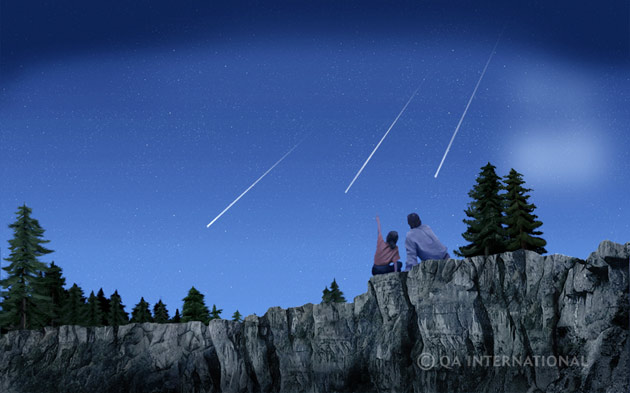Meteorites: these stones fallen from the sky
Every day, tons of cosmic material land on our planet! In fact, “extraterrestrial” rock fragments and dust particles are continuously attracted by Earth’s gravitation. As they enter the atmosphere at more than 62,000 miles per hour (100,000 kilometers an hour), they heat up and catch fire, forming a luminous trail. They are then called shooting stars (even though they are not stars), or, scientifically, meteors. Although most meteors burn up completely before they reach the ground, some of them collide with Earth’s surface, and then they are referred to as meteorites.

Shooting toward Earth
A meteor that does not burn up as it crosses the atmosphere becomes a meteorite. Hitting the ground, it partly disintegrates and creates a shockwave that spreads across Earth’s crust. The meteorite’s impact produces an explosion and a crater with raised borders, the size of which can be 10 to 20 times greater than that of the cosmic debris. Meteorite fragments can weigh anywhere from a few ounces (grams) to a few tons (metric tons) and spread over several miles (kilometers).

The scars of violent impacts
In the past, the falling of large meteorites would have led to the massive extinction of living things, such as the dinosaurs. Today, there is still a small probability that a major collision could occur. Traces of a hundred or so craters from major impacts can be found around the world, but our planet has probably been the victim of many more collisions.
Fifty thousand years ago, a massive meteorite about 164 ft (50 m) long crashed down in the Arizona desert. It formed the Meteor Crater (also called the Barringer Crater), which is about 3/4 mile (1.2 km) wide and 570 ft (175 m) deep.
The classification of meteorites
Meteorites essentially come from the asteroid belt, situated between Mars and Jupiter. It is estimated that two thirds of the meteorites that reach our planet’s surface are lost forever, since two thirds of the globe is covered in water. In spite of this, thousands of meteorites have been recovered in the last two centuries. Meteorites are true samples of our Solar System and have remarkable scientific value. Many of these fragments have been spotted in Antarctica, because they are easy to spot in the snow.
-
We distinguish three types of meteorites:
- Iron meteorites consist mainly of iron and nickel.
- Stony-iron meteorites consist of iron and rocky material.
- Stony (rocky) meteorites have a composition that is close to that of the Earth’s mantle and crust. They include chondrites and achondrites. The first group makes up the majority of known meteorites. They are probably the oldest in the Solar System. Achondrites are comparable to Earth’s basalt and come from the Moon and Mars.




